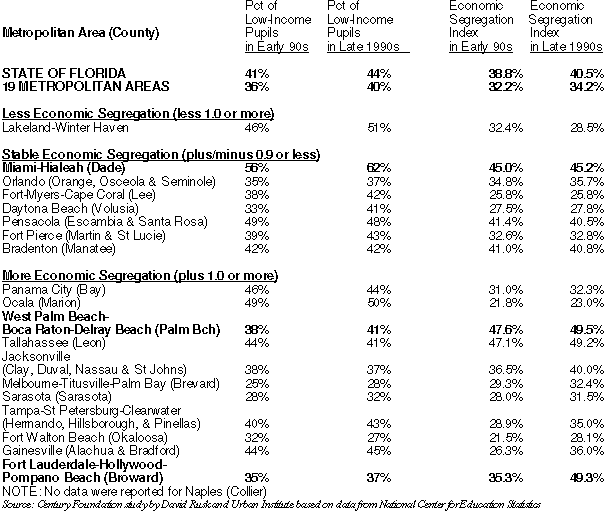
Back to Neighborhood Transformation mainpage
11/19/01: The following is data given by David Rusk on economic segregation throughout the state and excerpts from the speech he gave at the Florida Housing Coalition's recent annual meeting that connect housing opportunity with educational achievement.
ECONOMIC SEGREGATION TRENDS IN FLORIDA'S ELEMENTARY SCHOOLS IN 1990s
(Economic Segregation Index: Scale 0 to 100; 100 = Total Isolation of Low-Income Pupils)

Excerpts of David Rusk's October 23rd Speech
In America, housing policy is school policy. Where a child lives largely determines that child's educational opportunities. Affordable housing programs must not be measured just in terms of providing safe, affordable shelter for low- and moderate-income families. Such housing must also integrate low- and moderate-income children into mainstream, middle-class communities. Affordable housing must be opportunity housing.
In effect, to predict a school's average score on state standardized tests, I didn't need to know anything about the principal or the teachers' experience, pupil-teacher ratio, age of building, money spent per pupil, etc. Just tell me a school's percentage of low-income children and I could predict the school's average test scores (plus or minus six points) with 95 percent accuracy! The most important predictors of a child's academic performance are the income and educational attainment of the child's parents followed closely by the same factors for the parents of the child's classmates. Children learn from their peers - skills, attitudes, and aspirations. "The educational resources provided by a child's fellow students," sociologist James Coleman wrote, "are more important for his achievement than are the resources provided by the school board."
Why does where a child lives shape the child's educational opportunity? It's not how much the school board spends. It's who the child's classmates are. If that sounds too deterministic and negative, there is substantial research on a second, more optimistic point. Poor children learn best when surrounded by middle-class classmates in a predominantly middle-class school.
Mixed-Income Classrooms
My own studies have found that, for every one percent reduction in the percentage of a poor child's classmates that are also low-income, on average, that child's test scores will increase two- to three-tenths of one percent. In other words, moving a low-income child from a low-income school where 80 percent of classmates qualify for a free lunch to a middle-class school where only 20 percent of classmates qualify for a free lunch will, over time, yield a 12-18 percent improvement in the child's test scores. The results are even more dramatic in terms of high school graduation rates, continuing on to college, and other measures of lifetime opportunities.
What happens to middle-class children in more mixed-income classrooms? A smaller body of research finds that the academic performance of middle-class kids is unaffected until a school approaches majority low-income status. Even then, the academic decline of middle-class children observed may be more the result of higher income families pulling their children out of that school than any actual decline in performance by remaining middle-class children. In short, economic integration works. In fact, economic integration produces consistently greater educational improvement for low-income children than any of the educational reforms - more money, lower pupil-teacher ratios, new school buildings, etc. - commonly advocated.
That's the good news. The bad news is that America's public schools are becoming more economically segregated. This trend is confirmed by a study that I am just completing for the Century Foundation. The Urban Institute and I are examining enrollment trends by race and income, state by state, metro area by metro area, in all the nation's elementary schools.
In Florida, for example, despite the longest economic expansion in our nation's history, the percentage of low-income pupils statewide increased from 41 percent in the early 1990s to 44 percent by the decade's end. Using a common measure of relative segregation in which 100 means total economic isolation of poor children, Florida's statewide index increased from 39 to 41.
In Florida's 20 metro areas, economic segregation only diminished in the Lakeland-Winter Haven (Polk County) schools. The degree of economic segregation was stable in seven metro areas, including the Miami and Orlando regions. Economic segregation increased in the remaining eleven metro areas. The increases ranged from slight in Ocala-Marion County (from 22 to 23) to very substantial in Fort Lauderdale-Broward County (from 35 to 49).
Jim Crow by Income - Jim Crow by Race
Why was economic school segregation increasing? One factor in the South was that a much more conservative federal judiciary was steadily dismantling long-standing school desegregation plans. For two decades Southern schools had been much less segregated than Southern neighborhoods. Now, with the courts sending many African American students back to "neighborhood schools," they are sending them back to more racially segregated schools. And racially segregated schools are usually economically segregated schools.
But a more pervasive factor is that most metropolitan housing markets are becoming more economically segregated. Between 1970 and 1990, the index of economic segregation increased in 68 of the USA's 100 largest metro areas, including Tampa-St. Petersburg-Clearwater and Fort Lauderdale-Hollywood-Pompano Beach.
In effect, in a majority of major metro areas, Jim Crow by income is replacing Jim Crow by race. And Florida's public school enrollments increasingly reflect neighborhood housing patterns. Economically segregated neighborhoods mean economically segregated schools. Mixed income neighborhoods mean mixed-income schools.